
The Advanced Gas-cooled Reactor (AGR) is a type of nuclear reactor designed and operated in the United Kingdom. These are the second generation of British gas-cooled reactors, using graphite as the neutron moderator and carbon dioxide as coolant. They have been the backbone of the UK's nuclear power generation fleet since the 1980s.

A nuclear power plant (NPP) is a thermal power station in which the heat source is a nuclear reactor. As is typical of thermal power stations, heat is used to generate steam that drives a steam turbine connected to a generator that produces electricity. As of August 2023, the International Atomic Energy Agency reported there were 412 nuclear power reactors in operation in 31 countries around the world, and 57 nuclear power reactors under construction.
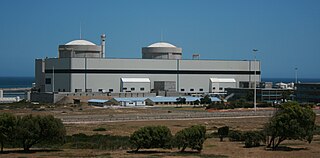
Koeberg Nuclear Power Station is a nuclear power station in South Africa. It is currently the only one on the entire African continent. It is located 30 km north of Cape Town, near Melkbosstrand on the west coast of South Africa. Koeberg is owned and operated by the country's only national electricity supplier, Eskom.

The Palo Verde Generating Station is a nuclear power plant located near Tonopah, Arizona, in western Arizona. It is located about 45 miles (72 km) west of downtown Phoenix. Palo Verde generates the largest amount of electricity in the United States per year, and has the second largest rated capacity. It is a critical asset to the Southwest, generating approximately 32 million megawatt-hours annually.

Oyster Creek Nuclear Power Station was a single unit 636 MWe boiling water reactor power plant in the United States. The plant is located on an 800-acre (3.2 km2) site adjacent to Oyster Creek in the Forked River section of Lacey Township in Ocean County, New Jersey. At the time of its closure, the facility was owned by Exelon Corporation and, along with unit 1 at Nine Mile Point Nuclear Generating Station, was the oldest operating commercial nuclear power plant in the United States. The plant first started commercial operation on December 23, 1969, and is licensed to operate until April 9, 2029, but Oyster Creek was permanently shut down in September 2018. The plant got its cooling water from Barnegat Bay, a brackish estuary that empties into the Atlantic Ocean through the Barnegat Inlet.

The Callaway Plant is a nuclear power plant located on a 2,767 acres (1,120 ha) site in Callaway County, Missouri, near Fulton, Missouri. It began operating on December 19, 1984. The plant, which is the state's only commercial nuclear unit, has one 1,190-megawatt Westinghouse four-loop pressurized water reactor and a General Electric turbine-generator. It is owned by the Ameren Corporation and operated by subsidiary Ameren Missouri. It is one of several Westinghouse reactors built to a design called Standard Nuclear Unit Power Plant System, or SNUPPS.

The Millstone Nuclear Power Station is the only nuclear power plant in Connecticut and the only multi-unit nuclear plant in New England. It is located at a former quarry in Waterford. With a total capacity of over 2 GW, the station produces enough electricity to power about 2 million homes. The operation of the Millstone Power Station supports more than 3,900 jobs, and generates the equivalent of over half the electricity consumed in Connecticut.
The Waterford Steam Electric Station, Unit 3, also known as Waterford 3, is a nuclear power plant located on a 3,000-acre (1,200 ha) plot in Killona, Louisiana, in St. Charles Parish, about 25 miles (40 km) west of New Orleans.

The Shippingport Atomic Power Station was the world's first full-scale atomic electric power plant devoted exclusively to peacetime uses. It was located near the present-day Beaver Valley Nuclear Generating Station on the Ohio River in Beaver County, Pennsylvania, United States, about 25 miles (40 km) from Pittsburgh.

Hurricane Ethel was one of two major hurricanes in the 1960 Atlantic hurricane season. The sixth known tropical cyclone, fifth named storm, and fourth hurricane of the season, Ethel developed from a disturbance in the Gulf of Mexico on September 14. After becoming a tropical storm, Ethel rapidly intensified and became a hurricane six hours later. By early on September 15, the storm reached major hurricane intensity when it became a Category 3 hurricane on the Saffir–Simpson hurricane scale. However, shortly thereafter, Ethel rapidly weakened back to a Category 1 hurricane while brushing eastern Louisiana. Later on September 15, Ethel weakened to a tropical storm. Early on the following day, Ethel made landfall in Pascagoula, Mississippi. The storm gradually weakened inland, before eventually dissipating over southern Kentucky on September 17.
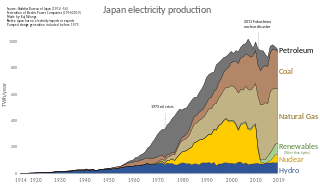
Energy in Japan refers to energy and electricity production, consumption, import and export in Japan. The country's primary energy consumption was 477.6 Mtoe in 2011, a decrease of 5% over the previous year.
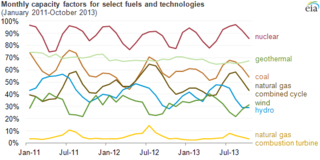
The net capacity factor is the unitless ratio of actual electrical energy output over a given period of time to the theoretical maximum electrical energy output over that period. The theoretical maximum energy output of a given installation is defined as that due to its continuous operation at full nameplate capacity over the relevant period. The capacity factor can be calculated for any electricity producing installation, such as a fuel consuming power plant or one using renewable energy, such as wind or the sun. The average capacity factor can also be defined for any class of such installations, and can be used to compare different types of electricity production.
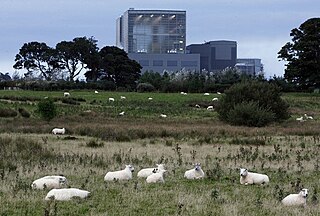
Hunterston B nuclear power station is a shut down AGR nuclear power station in North Ayrshire, Scotland. Located about 6 miles (9.7 km) south of Largs and about 2.5 miles (4.0 km) north-west of West Kilbride on the Firth of Clyde coast. It is currently operated by EDF Energy, and began producing electricity in 1976. The station ceased generation on 7 January 2022. On 19 May 2022, EDF announced that defueling was started on the two Hunterston B units. This process is expected to take over three years to complete, and it involves the complete emptying of all fuel channels from both reactors. This amounts to over 300 channels from each reactor, each containing 8 fuel elements. Fully loaded flasks containing the used fuel are scheduled to be dispatched from the site by rail to Sellafield at a maximum rate of three per week.
The South of Scotland Electricity Board (SSEB) generated, transmitted and distributed electricity throughout the south of Scotland, including the former regions of Strathclyde, Lothian, Fife, Central, Borders and Dumfries and Galloway and a few towns in northern England. It operated from 1955 to 1991.
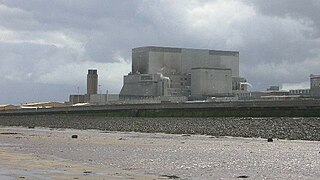
Hinkley Point B nuclear power station is a nuclear power station near Bridgwater, Somerset, on the Bristol Channel coast of south west England. It was the first commercial Advanced Gas Cooled reactor to generate power to the National Grid in 1976 and shares its design with sister station Hunterston B nuclear power station. It ceased operations permanently on 1 August 2022.
A load-following power plant, regarded as producing mid-merit or mid-priced electricity, is a power plant that adjusts its power output as demand for electricity fluctuates throughout the day. Load-following plants are typically in between base load and peaking power plants in efficiency, speed of start-up and shut-down, construction cost, cost of electricity and capacity factor.
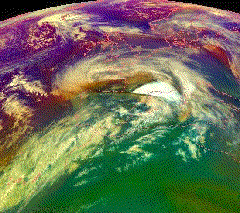
European windstorms are powerful extratropical cyclones which form as cyclonic windstorms associated with areas of low atmospheric pressure. They can occur throughout the year, but are most frequent between October and March, with peak intensity in the winter months. Deep areas of low pressure are common over the North Atlantic, and occasionally start as nor'easters off the New England coast. They frequently track across the North Atlantic Ocean towards the north of Scotland and into the Norwegian Sea, which generally minimizes the impact to inland areas; however, if the track is further south, it may cause adverse weather conditions across Central Europe, Northern Europe and especially Western Europe. The countries most commonly affected include the United Kingdom, Ireland, the Netherlands, Norway, Germany, the Faroe Islands and Iceland.
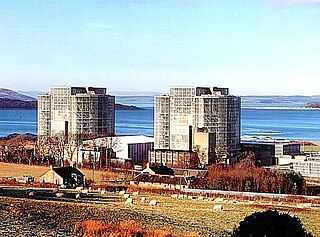
Hunterston A nuclear power station is a former Magnox nuclear power station located at Hunterston in Ayrshire, Scotland, adjacent to Hunterston B. The ongoing decommissioning process is being managed by Nuclear Decommissioning Authority (NDA) subsidiary Magnox Ltd.

The Cruachan Power Station is a pumped-storage hydroelectric power station in Argyll and Bute, Scotland. The scheme can provide 440 MW of power and produced 705 GWh in 2009.

The United Kingdom has a National Grid that covers most of mainland Great Britain and several of the surrounding islands, as well as some connectivity to other countries. The electrical sector supplies power at 50 Hz AC, and ~240 volts is supplied to consumers. In 2020 the electricity sector's grid supply came from 55% low-carbon power, 36.1% fossil fuelled power, and 8.4% imports. Renewable power is showing strong growth, while fossil fuel generator use in general and coal use in particular is shrinking, with historically dominant coal generators now mainly being run in winter due to pollution and costs, and contributed just 1.6% of the supply in 2020.



















